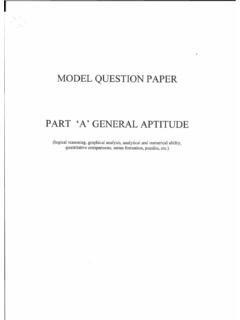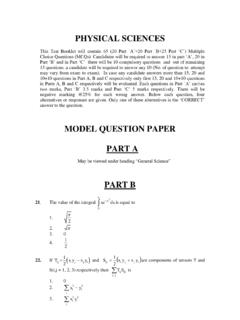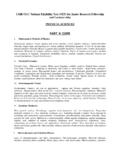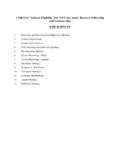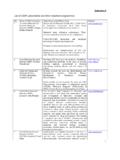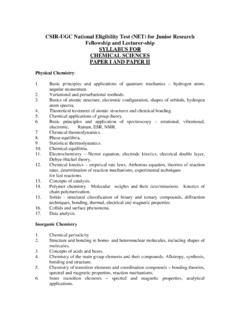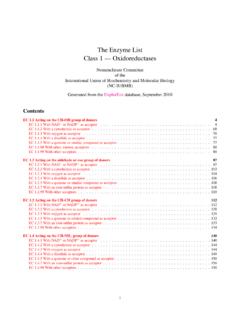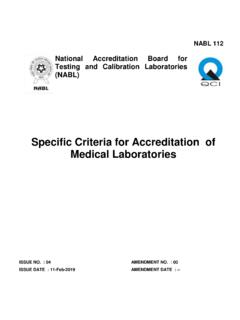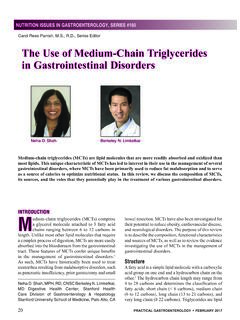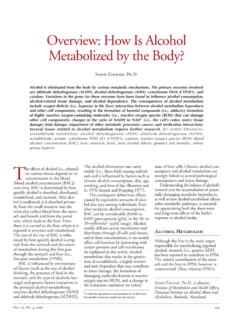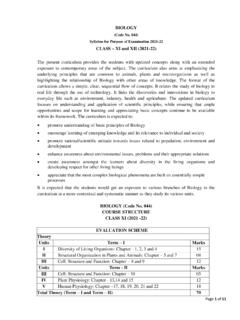Transcription of CSIR-UGC National Eligibility Test (NET) for Junior ...
1 CSIR-UGC National Eligibility Test (NET) for Junior Research Fellowship and Lecturer-ship LIFE SCIENCES 1. Molecules and their Interaction Releva nt to Biology 2. Cellular Organization 3. Fundamental Processes 4. Cell Communication and Cell Signa ling 5. Deve lopmental Biology 6. System Physiology Plant 7. System Physiology Animal 8. Inheritance Biology 9. Diversi ty of Life For ms 10. Ecological Principles 11. Evolution and Beha vior 12. Applied Biology 13. Methods in Biology 1. MOLECULES AND THEIR INTERACTION RELAVENT TO BIOLOGY A. Structure of atoms, molecules and chemical bonds. B Composition, structure and func tion of biomolecules (carbohydrates, lipids, pr oteins, nucleic acids and vitamins). C. Stablizing interactions (Van der Waals, electrostatic, hydrogen bonding, hydr ophobic interaction, etc.)
2 D Principles of biophysical chemistry (pH, buffer, reaction kinetics, thermodynamics, colligative properties). E. Bioenergetics, glycolysis, oxidative phosphorylation, coupled reaction, group transfer, biological energy transducers. F. Principles of catalysis, e nzymes and enz yme kinetics, enzyme regulation, mecha nism of enz yme catalysis, isozymes G. Conformation of proteins (Ramacha ndran plot, secondary structure, domains, motif and folds). H. Conformation of nucleic acids (helix (A, B, Z), t-RNA, micro-RNA). I. Stability of proteins and nucleic acids. J. Metabolism of carbohydr ates, lipids, amino acids nucleotides and vitamins. 2. CELLULAR ORGANIZATION A) Membrane structure and function (Structure of model membrane, li pid bila yer and membrane protein diffusion, osmosis, ion channels, active transport, membrane pumps, mechanism of sorting and regulation of intracell ular transport, electrical properti es of membranes).
3 B) Structural organization and function of intracellular organelles (Cell wall , nucleus, mitochondria, Golgi bodies, lysosomes, endoplasmic reticulum, peroxisomes, plastids, vacuoles, chloroplast, structure & function of cytoskeleton and its role in motilit y). C) Organization of genes and chromosomes (Operon, unique and repetitive DNA, interrupted genes, gene families, structure of chromatin and chromosomes, heterochromatin, euchromatin, transposons). D) Cell division and cell cycle (Mitosis and meiosis, their regulation, steps in cell cycle, regulation and control of cell cycle). E) Microbial Physiology (Growth yield and characteristics, strategies of cell division, stress response) 3. FUNDAMENTAL PROCESSES A) DNA replication, repair and recombination (Unit of repli cation, enzymes involved, repli cation ori gin and repli cation fork, fideli ty of replication, extrachromosomal repli cons, DNA damage and repair mechanisms, homologous and site-specific recombination).
4 B) RNA synthesis and processing (transcri pti on factors and machinery, formation of initiation complex, transcription activator and repressor, RNA polymerases, capping, elongation, and termination, RNA processing, RNA editing, spli cing, and polyadenylation, structure and function of different types of RNA, RNA transport). C) Protein synthesis and processing (Ribosome, formation of initiation complex, initiati on factors and their regulation, elongation and elongation factors, termination, genetic code, aminoacylation of tRNA, tRNA-identity, aminoacyl tRNA synthetase, and translational proof-reading, translational inhibitors, Post- translational modification of proteins). D) Control of gene expression at transcription and translation level (regulati ng the expression of phages, viruses, prokaryotic and eukaryotic genes, role of chromatin in gene expression and gene sil encing).
5 4. Cell communication and cell signaling A) Host parasite interaction Recognition and entry processes of different pathogens like bacteria, viruse s into animal and plant host ce lls, alteration of host ce ll behavior by pathogens, virus-induced cell transformation, pathogen-induced disease s in animals and plants, ce ll-ce ll fusion in both normal and abnormal ce lls. B) Cell signaling Hormones and their receptors, ce ll su rface receptor, signaling through G-protein co upled receptors, signal transduction pathways, se cond messengers, regulation of signaling pathways, bacterial and plant two- component sy stems, light signaling in plants, bacterial ch emotaxis and quorum sensing. C) Cellular communication Regulation of hematopoiesis, general principles of ce ll co mmunication, ce ll adhesion and roles of different adhesion molecules, gap juncti ons, extracellular matrix, integrins, neurotransmission and its regulation.
6 D) Cancer Genetic rearrangements in progenitor ce lls, onco genes, tumor suppressor genes, cancer and the cell cy cle, virus-induced ca nce r, metastasis, interacti on of cancer ce lls with normal cells, apoptosis, therapeutic interventions of uncontrolled cell growth. E) Innate and adaptive immune system Cells and molecules involved in innate and adaptive immunity, antigens, antigenicity and immunogenicity. B and T ce ll epitopes, structure and function of antibody molecules. generation of antibody diversity, monoclonal antibodies, antibody engineering, antigen-antibody interactions, MHC molecules, antigen processing and presentation, acti vation and differentiation of B and T ce lls, B and T cell receptors, humoral and ce ll- mediated immune responses, primary and se co ndary immune modulation, the complement sy stem, Toll- like receptors, cell-mediated effector functions, inflammation, hypersensitivity and autoimmunity, immune response during bacterial (tuberculosis), parasitic (malar ia) and viral (HIV) infections, congenital and acq uired immunodeficiencies, vaccines.
7 5. DEVELOPMENTAL BIOLOGY A) Basic concepts of deve lopment : Potency, commitment, specification, induction, competenc e, de termina tion and differentiation; morphogene tic gradients; cell fate and cell lineages; stem cells; genomic equivalenc e and the cytoplasmic determinants; impr inting; mutants and trans genics in analysis of deve lopment B) Gametogenesis, fertilizat ion and ear ly deve lopment: Production of gametes, cell surface molecules in sperm-egg recognition in animals; embryo sac de ve lopment and double fertilization in plants; zygote formation, cleavage , blastula for mation, embryonic fields, gastrulation and formation of ge rm layers in animals; embryoge ne sis, establishment of symmetry in plants; seed formation and germination. C) Mor phogenesis and organogenesis in animals : Cell aggregation and differentiation in Dictyostelium; axes and pa ttern formation in Drosophila, amphibia and chick; or ganoge ne sis vulva formation in Caenorhabditis elegans, eye lens induction, limb development and regene ration in ve rtebr ates; differentiation of neur ons, post embryonic de ve lopment - larval formation, metamorphosis; environmental regulation of normal development; sex de termina tion.
8 D) Mor phogenesis and or ganogenesis in plants: Organization of shoot and root apical meristem; shoot and root deve lopment; leaf de velopment and phyllotaxy; transition to flowering, floral meristems and floral development in Arabidopsis and Antirrhinum E) Programmed cell deat h, aging and senescence 6. SYSTEM PHYSIOLOGY - PLANT A. Photosynthesis - Light harvesti ng complexes; mech anisms of electron transport; photoprotect ive mech anisms; CO2 fixation-C3, C4 and CAM pathways. B. Respiration and photorespiration Citric acid cy cle; plant mitoch ondrial electron transport and ATP sy nthesis; alternate oxidase ; photorespiratory pathway. C. Nitrogen metabolism - Nitrate and ammonium assimilation; amino acid biosynthesis. D. Plant hormones Biosynthesis, storage, breakdown and transport; physiological effects and mech anisms of action.
9 E. Sensory photobiology - Structure, function and mechanisms of action of phytoch romes, cr yptoch romes and phototropins; stomatal movement; photoperiodism and biological clocks. F. Solute transport and photoassimilate translocation uptake , transport and translocation of water, ions, so lutes and macr omolecu les from soil, through ce lls, acr oss membranes, through xylem and phloem; transp iration; mech anisms of loading and unloading of photoassimilates. G. Secondary metabolites - Biosynthesis of terpenes, phenols and nitrogenous compounds and their rol es. H. Stress physiology Responses of plants to biotic (pathogen and insects) and abiotic (water, temperature and salt) st resses. 7. SYSTEM PHYSIOLOGY - ANIMAL A. Blood and circulation - Blood co rpuscles, haemopoiesis and formed elements, plasma functi on, blood volume, blood volume regulation, blood groups, haemoglobin, immunity, haemostasis.
10 B. Cardiovascular System: Comparative anatomy of heart structure, myogenic heart, specialized tissue, ECG its principle and significance, cardiac cy cle, heart as a pump, blood pressure, neural and chemical regulation of all above. C. Respiratory system - Compariso n of respiration in different species, anatomical considerations, transport of gase s, exchange of gases, waste elimination, neural and chemical regulation of respiration. D. Nervous system - Neurons, action potential, gross neuroanatomy of the brain and spinal cord, central and peripheral nervous sy stem, neural control of musc le tone and posture. E. Sense organs - Vision, hearing and tactile response . F. Excretory system - Comparative physiology of excretion, kidney, urine formation, urine concentration, waste elimination, mict urition, regulation of water balance, blood volume, blood pressure, electrolyte balance, aci d-base balance.
